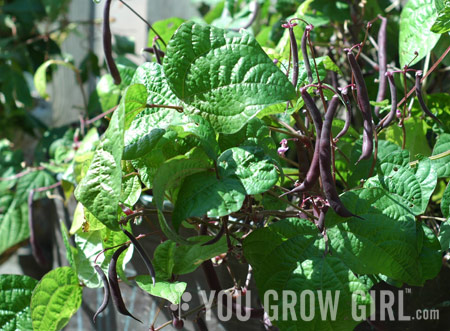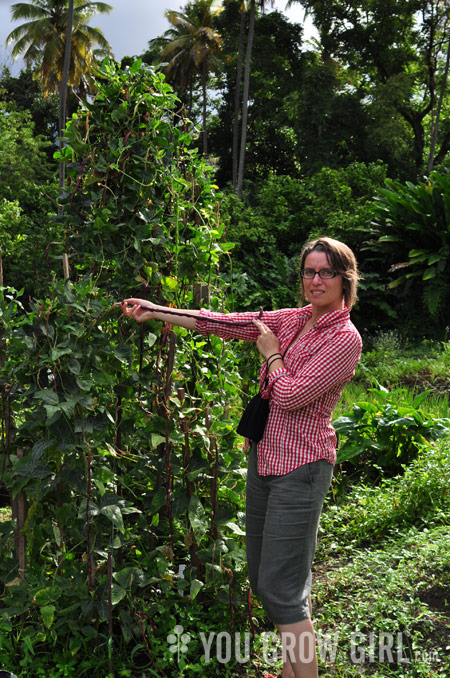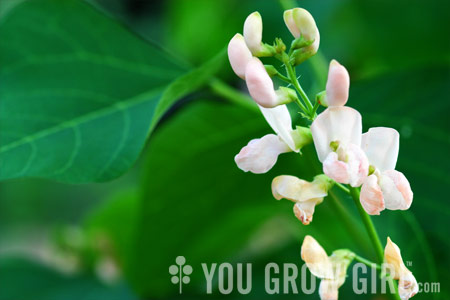
My second article of this season’s Globe & Mail column was published last Saturday: BEANS! It’s still not too late to get started. When I wrote and submitted the article we were experiencing a very hot and dry spring: great weather for planting beans. Immediately after the article was published the weather turned cold and wet: not so great weather for planting beans. What? Regardless, the beans I planted are popping up through the soil and look great. No rot or germination problems. Get those beans going!
Oh and if you’re wondering what I narrowed it down to: ‘Royal Burgundy’, ‘Dragon’s Tongue’, ‘Trionfo Violetto’, and two types of ‘Yard Long’ beans (green and ‘Red Noodle’). Basically everything I wrote about in the article. Writing the articles tends to renew my own excitement about plants or specific varieties I haven’t grown in a while.

This is me back in January in St. Lucia standing next to a gigantic tripod of ‘Red Noodle’ beans and holding one up against my arm for length.
———————-
While I’m on the topic of the Globe & Mail: I’ll be doing a live web chat tomorrow, Friday, June 11 at noon EST over here.
———————-
From bush to broad, every bean variety has a story
Now is the time to plant beans: The soil and air temperatures have warmed up and the chance of frost or a freak hailstorm is a thing of the past. I’ve got my pots at the ready and a small patch set aside at the in-ground garden. All that remains is deciding which of the 30 or so varieties I’ve collected will make it into the soil.
When it comes to bean seeds, you see, I’ve got a bit of hoarding problem. It’s not so much the flavour — I’m really not much of a bean eater — but the deluge of interesting varieties, each with their own captivating story. And I’m a sucker for a good story.
Since bean varieties number in the thousands, it should come as no surprise that there is a bean for every garden (and gardener). Container and balcony gardens fair best with bush beans, low-growing plants that don’t require staking. My favorite is ‘Royal Burgundy’, an attractive variety that produces loads of tender, purple-podded snap beans. Try ‘Tongue of Fire’, ‘Dragon’s Tongue’ or ‘Cherokee Trail of Tears’ if you prefer dual-purpose heirlooms that can be eaten young as snap beans or allowed to mature into tasty storage and soup beans.
Grow bush varieties in wide pots that are no less than 12 inches deep. Old metal washbasins and re-purposed tote boxes and recycling bins are good choices. Bush beans only produce one crop and they do it all at once. Plant over several week-long intervals to stagger the harvest or all at once if you desire a glut worthy of canning.

Pole and runner beans, on the other hand, are the big fellas that require a trellis or staking system to provide vertical support. Despite their size, these tall plants are a decent space-saving option provided you have room for a large, 16-inch pot. Unlike bush varieties, they will keep rolling out the harvest straight through to fall. ‘Trionfo Violetto’ is an impressive all-purple Italian variety that turns out very slim pods, not unlike the green French fillet types that cost an arm and a leg in gourmet food shops. Old-fashioned runner beans offer an ornamental option — their brightly hued flowers are edible along with the beans. Choose ‘Scarlet’ for loads of vibrant red blooms or ‘Sunset’ if you prefer soft pinky/peach. ‘Golden Sunshine’ is dramatic, with bright red flowers on gold foliage.
The coming summer is predicted to be very sunny, hot and arid. I’m taking advantage of this punishing weather to try my hand at ‘Chinese Long’ (a.k.a. ‘Yard Long’) beans, a Southeast Asian delicacy that produces pendulous, 18-inch beans with a pea-like flavour — even the leaves and stems are edible. Just about all beans grow best in the summer, with the exception of broad beans or favas, the only type that are started in the springtime. All other beans hate cold, wet weather — they’ll rot in the ground if you set them out before the spring rains have let up. Before planting, soak your beans overnight and plant about an inch deep directly into their final growing spot outdoors. Soybeans are the exception to this rule — soaking them nearly always results in rot. Sow bush beans about three to four inches apart and double the spacing for pole or runner beans. It is not absolutely necessary, however; dipping the beans into a legume inoculant before planting can help to increase your yield.
Beans mature shockingly fast. Start picking snap beans daily about two months after planting and keep drying beans on the plant until the shells dry out.
Great imformative article. I love beans but havent tried the ones you talked about. I must look for them as its not too late to plant on the west coast.
… thanks for the reminder and tips about staggering the bean plantings! I am going to the allotment today to see if my scarlet runners are up yet!
Beans. They really are the magical fruit.
Rabbits have eaten all my beans… :( This was one of my favorite vegetables to grow – easy, good for soil, high yielding. Now it’s bunny food. No more beans for me… at least not until I install a real fence around the veggie patch.
Ciao Gayla-
What’s your source for the Golden Sunshine Runners? I’m SO excited about my Sunset Runners this year! I sowed them in 4″ cells earlier before their bed was tilled and they’re doing great!
You’ve got me thinking about the idea of sowing some of the more tropical varieties. I don’t have room for the Red Noodles, but I do have some Asparagus Winged Beans from Hawaii. Maybe I’ll give those a try. I soaked my Agate Soybeans for about 10 minutes before dusting them with inoculant. Hopefully that’s not too long.
Here’s to a really great bean year! After last year, we could use one!
That was a great article. You can’t control the weather. Lucky you that your beans are still coming up okay!
You’ve inspired me to go out and sow some bush beans. My climbing french and broad beans are well on their way, but I like the sound of those tongue varieties. And I’m tempted to try those ‘Chinese Long’…
Oh wow. I didn’t know they would grow that much.
Suzanne
Should I just stake beans the same way I stake peas? Or are there any bean-specific tricks?
Sorellina: Territorial Seeds: http://www.territorialseed.com/product/9837/s Where did you get yours? I haven’t seen them anywhere else.
emilygrace: I always do tripod style for pole beans. Bush beans sometimes require staking if the beans get too heavy and pull the plant down. If they are grown in rows you can just string a thin rope across each row or do groupings of plants with smaller tripods… pea staking works too.
Ciao Gayla-
Cottage Gardener has Sunset Runners. So does Seed Savers Exchange, but Cottage Gardener is always at Seedy Saturday so that’s where I picked mine up.
Sorellina: Good to know! Was looking for a local supply. Thanks!
Great information Gayla. My bush beans have just sprouted and my pole beans should be up soon. My garden is in zone 3 so I always look for the varieties with the fewest days to maturity.
The beans in that picture are unbelievable.
I’ve planted Royal Burgundy and Scarlet Runners. Most of them are not coming up! I soaked them before planting and everything. Wonder what I’m doing wrong…
Caught your article in the Globe the other week and am loving your column. Wish it was weekly!
My orca beans have all sprouted, but I was totally dismayed yesterday to discover that something made a snack of the big beautiful leaves – they’re all almost entirely eaten through. Any advice? I desperately want to save them!
Daniela: I’m having the same problem in one of the gardens. My leaves are completely gone. It looks like mammal damage to me, but unfortunately I’m not there enough to really know.
If it’s eating the leaves in pieces it could be bean leaf beetles or Mexican bean beetles…. slugs are another option.
In my case, because I think it is a mammal, I’m going to cover mine with a water bottle or some other barrier to keep the animal from getting at it.
I’ve grown Royal Burgundy and Dragon Tongue. Both are pretty. I really love the taste of the Dragon Tongue. It was really tender and sweeter. Yum! I’ve had no success with runner beans. :( Too bad. They have gorgeous flowers!